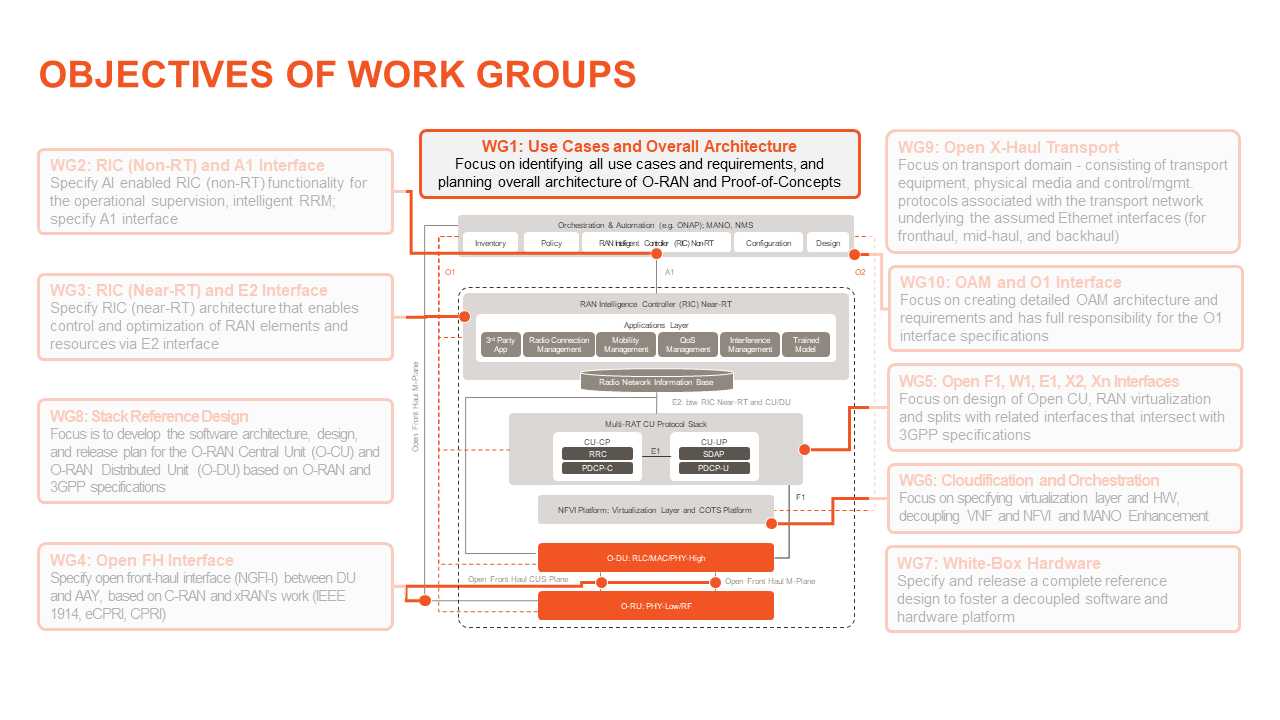O-RAN Alliance Workgroup 1: Task Groups and Deliverables
After having looked at the O-RAN Technical Steering Committee (TSC) and the Workgroups (WGs) in the last post, we now turn our attention to the O-RAN Alliance Workgroup 1 (WG1).

WG1 has the overall responsibility of the O-RAN Architecture and Use Cases. It identifies tasks to be completed within the scope of the Architecture and Use Cases and assigns task group leads to drive these tasks to completion while working across other O-RAN work groups.
Within WG1, there are several task groups and sub-task groups:
- The Architecture Task Group is responsible for the overall O-RAN architecture, so the team needs to be aware of all discussions within every other group. Similarly, all other work groups need to be notified of all the latest updates and changes in the architecture.
- The Use Case Task Group (UCTG) is responsible for identification of potential use cases enabled by O-RAN, definition of detailed top level use cases and inter-WG alignment, and finally, dissemination of these use cases. The dissemination would generally be in the form of O-RAN whitepapers, etc.
- The Network Slicing Task Group is responsible for the study of network slicing and its requirements in O-RAN, defining of O-RAN slicing use cases to submit to the Use Case Task Group, and finally, ensuring that the features are aligned between all different work groups.
- The Security Task Group (STG) is responsible for the development of an O-RAN security architecture, framework, and guidelines spanning across the entire O-RAN architecture. It specifies security requirements, architectures, and frameworks in support of the open interfaces defined by other O-RAN WGs. It is responsible for collecting the security requirements and solutions from all other WGs and negotiating as necessary to ensure uniform requirements and designs among the relevant WGs, thereby providing a standardized security architecture.
- The Demos and Proof of Concepts (POCs) Task Group helps members showcase their demos and POCs at events, either physically or virtually.
WG1 is also responsible for delivering the following specifications:
- O-RAN Architecture Description: This document identifies the key functions and interfaces adopted in O-RAN. It is the most important document, as it highlights the scope of O-RAN Alliance deliverables.
- O-RAN Use Cases Detailed Specification: This document describes the top-level use cases as identified by the Use Case Task Group (UCTG). For each use case, the document describes the motivation, resources, steps involved, and the data requirements. These top-level use cases are further detailed in relevant WGs along with the requirements for O-RAN components and their interfaces.
- Use Cases Analysis Report: This document describes potential O-RAN use cases as defined by the UCTG. The use cases are described at a very high level, emphasizing how the use is enabled by O-RAN architecture along with basic input data expectations and resulting actions. These high-level use cases are prioritized within O-RAN, and selected use cases are further detailed in the UCTG and other relevant O-RAN WGs to define the requirements for O-RAN components and their interfaces.
- Study on O-RAN Slicing: This document provides common terminology for slicing, an overview of slicing activities in different Standard Development Organizations (SDOs) such as 3GPP, ETSI, ONAP, GSMA, etc., and provides the high-level view of O-RAN slicing framework and architecture along with various deployment options.
- O-RAN Slicing Architecture: This document describes high-level O-RAN slicing-related use cases, requirements, and architecture. While some of the requirements are derived from use cases, some of the relevant SDO requirements are also captured as they have an impact on O-RAN functions. Along with requirements and reference slicing architecture, slicing-related impact to O-RAN functions and interfaces are captured as well.
- O-RAN Information Model and Data Models Specification: This document is both a specification as well as an informational report. It specifies the Information Model and the Data Models that lay the foundation for O-RAN’s model-driven architecture and for the functions carried out over O-RAN interfaces, e.g., management functions, procedures, operations, and corresponding solutions.
Due to the recent formation of the new working group, WG10 (OAM and O1 Interface), OAM related task groups and specifications have been transferred over to WG10.
I plan to discuss all other workgroups individually in future blog posts.
Further Reading:
- Introduction to O-RAN Philosophy
- Introduction to O-RAN Timeline and Releases
- An Overview of O-RAN Architecture
- O-RAN Technical Steering Committee (TSC) & Workgroups
- Why We Need the Open RAN Movement Even Though 3GPP Interfaces Are Already Open
- Parallel Wireless Reaches All G O-RAN Solution Milestone
- Everything You Need to Know About Open RAN: An e-Book